April 1956 Auto Age - Vol. 4, No. 4
|
Testing the KARMANN GHIA VW With performance to match its newly acquired good looks, this German masterpiece is destined to become a universal best seller. by D.M. Bartley |
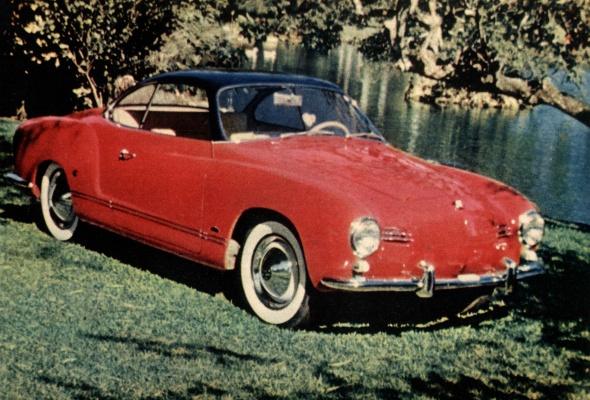
|
|
THERE SEEMS TO BE little doubt that Germany is
well on its way to emerging victorious as the leader in selling
foreign cars to Americans. Total figures for 1955 show that,
without making very much fuss about it, the Germans have moved
far ahead of the British. (The French and Italian manufacturers
only now are beginning to make any concerted bid for the
American market.) In fact, Germany is making a strong bid for
world automotive supremacy. Mercedes-Benz are selling ever increasing numbers of their cars in the U.S. (no doubt sales being spurred by their fine racing performances this past year), and there are any number of other German cars which almost seemed to have been designed with the American market in mind-for instance, the new Goertz B.M.W. and the restyled Borgwards. But the real credit for the new German supremacy doesn't belong to the sleek, high-powered, expensive cars. The laurels rest squarely on the bonnet of the squat little $1,500, 36-hp Volkswagen which has amazed even its own dealers by racking up a fabulous 35,000 sales in 1955, making it a clear leader in American foreign car sales. The standard VW has a lot to recommend it-it's relatively cheap to buy, very economical to operate, rugged and dependable as a result of being very well-designed and built. It starts in cold weather, runs at its top speed for hours, is easy to handle, requires very little maintenance and though a comfortable four-seater, is small enough to park almost anywhere. Furthermore, its de-tuned engine lends itself nicely to a certain amount of easy modification for more power and speed. |
There is only one honest and justified
criticism one hears about the VW it's so ugly. Even when one
comes to love it, it's with the same sort of resigned affection
one has for a particularly ungainly but endearing family mutt.
For those looking for a true utility car, this presents no
serious problem, but those sensitive lovers who wince each time
a disparaging comment is made about the sturdy little bug have
been deluging the heavens with prayers for a miracle which
would give an appropriately beautiful body to properly display
the lovable soul within. Finally their prayers have been answered. The gods, personified by Ghia, designed a new shell for the VW, and the German firm of Karmann undertook to produce the transformation in quantity. In the photographs which arrived in the U.S., the Cinderella car looked lovely. Finally a few of the actual Karmann-VWs arrived here, and on display, looked even more beautiful than in the pictures. We were eager to try it out. Only trouble was, there were so few in the country that we couldn't get hold of one. But the gods, this time in the guise of Mr. James A. Brundage, owner of Brundage Motors, Miami, Florida dealers for the VW, once again came to the rescue. During a conversation with him at Nassau, primarily about his several Porsche entries in the races, he said that if we cared to stop a day or so in Miami on our way back to New York, he'd be happy for us to borrow one of his Karmann VWs which, fortuitously enough, just happened to be nicely broken in. So early one very gray, un-Florida-like morning, several days later, we arrived at Mr. Brundage's Miami Springs showroom and were led immediately over to one of the most attractive little automobiles it's possible to imagine. |
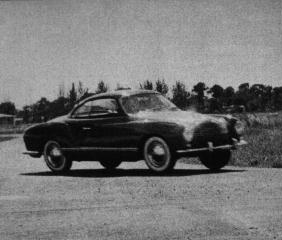 Vision is particularly fine in Karmann-Ghia design, posts being well placed and seating position good. Car has same turning radius as VW. |
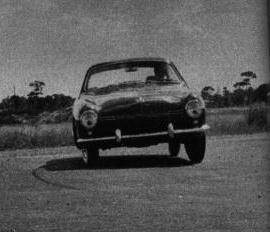 Karmann Ghia car has tighter suspension than stock VW, offers just as smooth a ride but can be cornered without undue lean at higher speed. |
|
The Karmann-Volkswagen is the sort of car
that you want to just walk around, touch, look into and admire
for the first ten minutes you see it. The over-all lines are
sleek. trim, clean and very appropriate for the size and design
of the car. Very little trim is used-but that little bit is
most effective. Particularly in one aspect, photographs of the
cars are misleading, for in actuality, the hood in front is not
so blunted or Porsche-ish as you would expect. The nicely
contoured bumper is also completely functional. The basic simplicity of the standard VW has been maintained in all important areas. On the far left of the dash is the ignition key which also acts as starter. Behind the steering wheel are the speedometer and clock. About dead center of the panel are two knobs, one for the windshield wipers and the other for lights, a radio grille and swivel ash tray. On the far right is a glove compartment and above it a very convenient but inconspicuous assist grip for the front-seat passenger. That's all, and a welcome relief from the usual complexity of knobs, buttons and levers it is. The interior is finished not only with excellent workmanship but in excellent taste. Two bucket-type seats are upholstered in one-tone leatherette (cloth is available) as is the banquet-type rear seat. The back of the latter can be folded down to make a sizeable flat surface for luggage, a big dog or three weeks' groceries. At the rear, the clean, neat little VW engine is as accessible as ever and just as pretty. In the front, under the hood, lies a 9.3-gallon gas tank; the reserve tank (tapped by simply turning a lever located high on the fire wall right of the accelerator) is cleverly concealed somewhere beneath it. Behind the tank is room for a spare tire and a substantial amount of luggage. With only two people occupying the car, between the compartment under the hood and the area behind the front seats, enough luggage for a six months' trip could be carried easily. When you get into the ear, your smile of pleasure grows. The seats are individually adjustable as they should be, automatically compensating for height as they are moved. Visibility is as fine as you can imagine, the rear posts not wide enough to totally obstruct vision of a car following, regardless of its position, and the front posts not even noticeable to the driver. |
On the floor is a short shift lever for the
four forward speeds (top three synchromeshed) and reverse. It
is, at least for me, perfectly positioned. On the left of the
steering column, under the wheel, is an American-type turn
indicator- something I often miss on European cars. The
Karmann-Ghia VW has the same powerful heater-defroster unit as
the stock VW (the control knob conveniently placed on the floor
near the gearbox) and a similar, very effective ventilation
system via ducts and front panel ventilators. What is it like to drive? Well, in about the first twenty seconds, one is whacked over the head with three overpowering impressions. The little devil takes off in first with a very sports-car-type sound; the gearbox is like soft butter, permitting shifts so fast that it's hard to believe; and the ride is definitely more similar to that of an Austin Healey or MG than to any small family touring car. The VW synchromesh gearbox is a smooth one, but either I just don't remember quite how smooth or whoever broke in this particular Karmann-VW had the master's touch, for it would be difficult to imagine any improvement of any kind in this area. From second to third goes so easily that it would seem nigh onto impossible for the rankest novice driver to make a mistake. Same with reverse which, as on the standard VW, is reached by depressing the shift stick a very noticeable inch or so before moving it down to second. The substantial difference in ride as well as in cornering and general sway-free, fast maneuvering of the Karmann-built VW is attributable to two important modifications made to the suspension of the stock VW. A sway bar has been added between the two torsion bars in the front, and camber (angle) of the rear wheels has been reduced one or two degrees by slightly loosening the rear torsion bars. The results are that the car, even on pretty fast corners, remained level, did not nose-dive appreciably even when the excellent brakes were employed in panic-type stops, but still managed to absorb a large percentage of road shock, giving even a back-seat passenger an acceptably comfortable ride. |
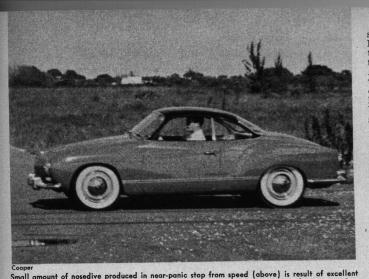 Small amount of nosedive produced in near-panic stop from speed (above) is result of excellent stock VW 6roxes, modification of rear-wheel camber, addition of sway bar to front suspension. |
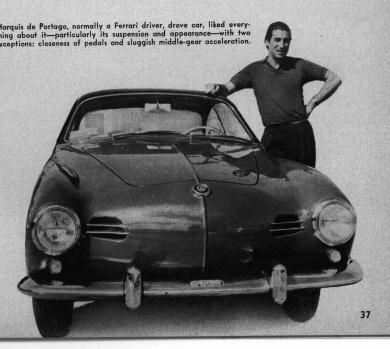 Marquis de Portago, normally a Ferrari driver, drove car, liked everything about it-particularly its suspension and appearance-with two exceptions: closeness of pedals and sluggish middle-gear acceleration. |
|
Might mention that our backseat passenger
complained that though the foam-rubber seat was comfortable
enough, the lack of very much leg room, difficulty in getting
in and out and complete lack of head room was annoying. These
faults are unfortunately inherent in the design of any two
passenger car which has some provision for extra people and
certainly should not be considered major flaws in a vehicle
which is 13 ft. long over-all. I must admit that for several hours I felt a little like a Karmann VW salesman, for making an unscheduled test in Miami, without equipment or knowledge of areas where the car could be "played with" safely, I resorted to the expedient of dropping in on a variety of old Miami friends who played every variation on the theme of open-mouthed amazement-more at the beauty of the automobile than the unexpectedness of my visit-and taking them for rides through endless miles of downtown residential and country roads. In the course of these accompanied meanderings, I found that the position and size of the pedal controls didn't disturb me as they had during the first few minutes of driving. The side contour of the car is such that, sitting squarely in the driver's seat, one's legs must be swung slightly toward the center of the car to reach the brake and clutch pedals. These are very close together and very tiny. The throw is a little long for good proportioning. While the proximity of these pedals was all right for me, a slight re-designing could make an immense improvement. The accelerator is the narrow VW roller, strange to the foot of the uninitiated, but rather fun to use after a little practice. It is a perfectly good acceleration control, the fact that it is not like those used on many cars not constituting a valid criticism. Of course, a standard flat pedal could be installed for someone who doesn't change habits easily. |
In normal driving, the Karmann VW
acceleration aroused rather conflicting impressions. From a
standing start, before trying actual acceleration times, I had
the feeling that the car was wonderfully peppy right up through
the gears-this impression being so strong that I thought it
likely that some engine modifications had been made to increase
power. The feeling was completely dispelled when the car was
braked, downshifted and then accelerated again. That way the
pick-up seemed sluggish in both second and third gears. On
several occasions I felt the need of first-gear power but as
that gear is not synchromeshed, it requires double-clutching to
get into, and if the car is moving at more than two or three
miles an hour, even double-clutching won't produce a smooth,
fast downshift. In case you're wondering if the increased weight of the new body might be responsible, forget it-the Karmann-Ghia car weighs only 18 lbs. more than the standard VW convertible (1,782 and 1,764 lbs. respectively). The truth of the matter is that the firm suspension, the generally topnotch maneuverability, the tremendous responsiveness, fast gearbox and just about every other aspect of this car, including its appearance, makes you feel as if you're driving a sports car, and you are thus reminded now and then while accelerating that it is instead a particularly delightful sports-type car powered by a designed-for-dependability-ruggedness - economy - no - fine-tuning-necessary 1,192 cc, 36hp engine. Unfortunately, we delayed doing acceleration or top-speed runs a little too long, for by mid-afternoon the rains came with a vengeance. We tried a few runs - enough to say that even on wet pavement, there was no problem with wheelspin, even on quite fast take-offs. No brake-grab either, even in what were pretty close approximations of panic stops. |
|
The next day, Jerry Cooper, a young racing
driver who also works with the Brundage outfit, was kind enough
to run off acceleration tests, timed to the nearest second. He
got an average of six seconds for the 0to-30 mph run, 10
seconds for 0 to 40 (using first and second gears), 15 seconds
for 0 to 50 (first and third gears), and 22 seconds for 0 to 60
mph. On the 30-to-60 mph acceleration, the best time- 17
seconds-was obtained by using second and third gears. For top speed, the Karmann-VW reached an indicated 86 mph, averaged 82* mph on several flat-out runs. (A corrected speedometer was not available, the known error being approximately four per cent at 50 mph.) Back to the rain for a minute: only during a real downpour were we able to break away the rear end of the Karmann-VW, and that executing a very sharp left turn at well-above-average speed. It seems logical that someone driving a rear-engined car for the first time should take a little care in this area, for in spite of excellent suspension compensations for the rear weight, there is definitely a different "feel" in cornering any rear-engined car. In the hands of a driver unaccustomed to it, or even in the hands of an experienced but over-enthusiastic driver, any such car tends to be a little "tail-happy." It is certainly worth mentioning, too, that the beautiful little car is tight as a drum. Miami offered not the least little hump of a hill to try the Karmann VW's climbing ability, reputed to be about the same as that of the stock VW which can handle as much as a 37-per-cent grade in first gear. As not one single one of the other claims made about the car proved, in our experience, to be at all exaggerated, we'll take that one on faith. |
One of our passengers-and drivers-was the
Marquis de Portago. We always like to have at least a few
competent outside opinions of cars we test, so we felt a little
lost in Miami, so far from home base. We were, therefore,
particularly appreciative of the Marquis' willingness to use a
good part of the few hours he was in Mian1i, fresh from three
brilliant victories at the Nassau races, to drive the
Karmann-VW. His opinion? On the whole, he was as enthusiastic as we were about the car, commenting especially about its fine suspension, smooth gearbox' easy handling and extraordinarily handsome design. He also felt that the second- and third-gear acceleration was too slow -not a surprising reaction for someone who just drove a Monza Ferrari at speed for several hundred miles -and was a great deal stronger in his objection to the closeness of the clutch and brake pedals than I was. Even though he has what one might call a somewhat larger "footal" area than I have, this is the one criticism I think is justified. One does get used to it, though. If Volkswagen could sell 35,000 cars in America in 1955, under the handicap of a very new and I still growing dealership set-up and a New York distributor caught entirely unprepared for such success, it is rather staggering to think about their sales in 1956 when their new New Jersey assembly plant will be in operation and when the VWs with Karmann-Ghia coachwork arrive in quantity. The list price of the latter is $2,39~$900 more than the standard VW sedan. But the Karmann Ghia car gives, in our opinion, full value in unusual beauty and fine workmanship superimposed on the already numerous assets of the Volkswagen. |
|
TRANSMISSION: four forward speeds and reverse with synchromesh on top three gears. SUSPENSION: front, independent suspension through longitudinal torsion arms, two laminated square section torsion bar springs passing through beams, rear, independent suspension through swinging half axles with spring plates, one round torsion bar spring on each side; shock absorbers, double-acting telescopic. BRAKES: four-wheel hydraulic. DIMENSIONS: wheel base, 94.5 in., track, 50.8 in. in front, 49.2 in. rear; width, 64.2 in. (3.6 in. wider than stock VW); height 52.2 in. (7 in. lower); over-all length, 163 in. (2.8 in. longer); ground clearance, 6.8 in.; turning circle, 36 ft. (approx.); curb weight, 1782 lbs. (18 lbs. heavier). ACCELERATION: Zero to 30 mph: 6 seconds, Zero to 40 mph: 10 seconds, Zero to 50 mph: 15 seconds, Zero to 60 mph: 22 seconds, 30 to 60 mph: 17 seconds TOP SPEED: 75+ |